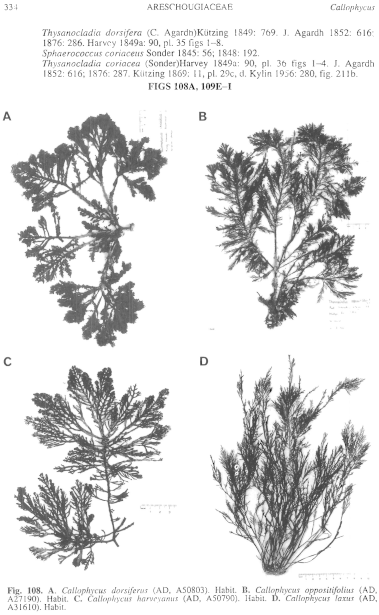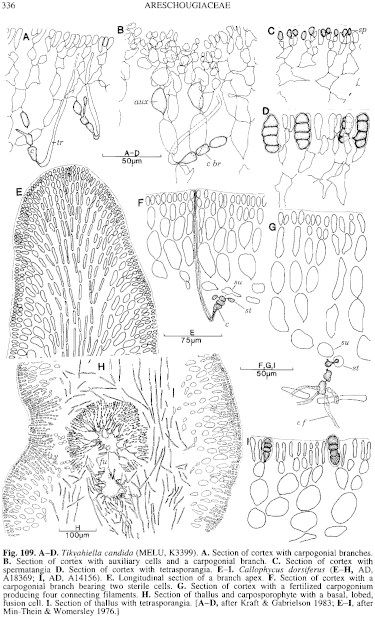|
|
|
|
|
|||||||||||
|
Electronic Flora of South Australia Species Fact Sheet
Phylum Rhodophyta – Class Florideophyceae – Order Gigartinales – Family Areschougiaceae
Selected citations: Min-Thein & Womersley 1976: 15, figs 3, 4, 50.
Synonyms
Rhodomela dorsifera C. Agardh 1822: 372; 1824: 197.
Thysanocladia dorsifera (C. Agardh) Kützing 1849: 769. J. Agardh 1852: 616; 1876: 286. Harvey 1849a: 90, p1. 35 figs 1–8.
Sphaerococcus coriaceus Sonder 1845: 56; 1848: 192.
Thysanocladia coriacea (Sonder) Harvey 1849a: 90, pl. 36 figs 1–4. J. Agardh 1852: 616; 1876: 287. Kützing 1869: 11, pl. 29c, d. Kylin 1956: 280, fig. 211b.
Thallus (Fig. 108A) dark red-brown, 10–25 cm high, with a short, subterete stipe producing several complanately branched, bipinnate fronds. Axes 5–8 mm broad, with a broad midrib, bearing close set, distichous, subopposite, flat, pinnae which are similarly branched with pinnules also flat and 1–2 mm broad and bearing short ramuli 1–2 (–3) mm long forming marginal serrations. Holdfast discoid, 5–15 mm across; epilithic. Structure (Fig. 109E) multiaxial, with a central medullary core of mainly longitudinal, branched filaments and rhizoids, and a pseudoparenchymatous cortex 4–7 (–10) cells thick, inner cells ovoid, (12–) 20–40 µm in diameter, decreasing to outer cells 2–4 µm in diameter, LID 1.5–2.5. Rhodoplasts discoid to ribbon shaped, several per cell.
Reproduction: Sexual reproduction non-procarpic. Carpogonial branches (Fig. 109F) 3–4 (–5)-celled, borne on an inner cortical cell with the first (and second) cell bearing 1–3 sterile cells, directed inwards and with a reflexed trichogyne. Connecting filaments (Fig. 109G) 4–7, unbranched and non-septate. Auxiliary cells inner cortical cells with adjacent cells darker staining and producing short chains of nutritive cells after diploidization, then producing a gonimoblast initial inwardly which gives a compact group of cells; later gonimoblasts develop radially from the fusion cell (Fig. 109H) which connects to the enlarged axial filament, and produce terminal chains of ovoid carposporangia 5–8 µm in diameter. Cystocarps often crowded, 0.5–1 mm across, protruding, with slight filamentous enveloping tissue, ostiolate. Spermatangia unknown.
Tetrasporangia (Fig. 109I) near pinnule ends, subnemathecial, scattered amongst elongate outer cells (L/D 6–8), basally attached, elongate-ovoid, 15–30 µm long and 8–12 µm in diameter, zonately divided.
Type from "Nov. Holl."; holotype in PC, part in Herb. Agardh, LD, 25552.
Selected specimens: mile beach, N of Dongara, W. Aust., drift (Womersley, 17.ix.1979; AD, A51353). Fremantle, W. Aust. (Harvey Alg. Aust. Exsicc. 307a; AD, A18369). King Head, Rottnest I., W. Aust., 4–6 m deep (Clarke & Engler, 6.ix.1979; AD, A50803). Point Peron, W. Aust., drift (Royce 399, 2.x.1949; AD, A14156). Hamelin Bay, W. Aust., 1–2 m deep (Clarke & Engler, 1.ix.1979; AD, A50618).
Distribution: Port Denison to Hamelin Bay, W. Aust.
Taxonomic notes: C. dorsiferus is essentially a west coast species, reaching to Hamelin Bay, just north of Cape Leeuwin. It is characterised by its closely bipinnate habit with relatively broad axes and pinnae, all flat and relatively thin.
References:
AGARDH, C.A. (1822). Species Algarum. Vol. 1, Part 2, pp. 169–398. (Berling: Lund.)
AGARDH, C.A. (1824). Systema Algarum. (Berling: Lund.)
AGARDH, J.G. (1852). Species Genera et Ordines Algarum. Vol. 2, Part 2, pp. 337–720. (Gleerup: Lund.)
AGARDH, J.G. (1876). Species Genera et Ordines Algarum. Vol. 3, Part 1 - Epicrisis systematis Floridearum, pp. i-vii, 1–724. (Weigel: Leipzig.)
HARVEY, W.H. (1849a). Nereis Australis, pp. 65–124, Plates 26–50. (Reeve: London.)
KÜTZING, F.T. (1849). Species Algarum. (Leipzig.)
KÜTZING, F.T. (1869). Tabulae Phycologicae. Vol. 19. (Nordhausen.)
KYLIN, H. (1956). Die Gattungen der Rhodophyceen. (Gleerups: Lund.)
MIN-THEIN, U. & WOMERSLEY, H.B.S. (1976). Studies on southern Australian taxa of Solieriaceae, Rhabdoniaceae and Rhodophyllidaceae (Rhodophyta). Aust. J. Bot. 24, 1–166.
SILVA, P.C. (1957). Remarks on algal nomenclature. Taxon 6, 141–145.
SONDER, O.G. (1845). Nova Algarum genera et species, quas in itinere ad oras occidentales Novae Hollandiae, collegit L. Preiss, Ph.Dr. Bot. Zeit. 3, 49–57.
SONDER, O.W. (1848). Algae. In Lehmann, C., Plantae Preissianae. Vol. 2, pp. 161–195. (Hamburg.)
The Marine Benthic Flora of Southern Australia Part IIIA complete list of references.
Publication:
Womersley, H.B.S. (14 January, 1994)
The Marine Benthic Flora of Southern Australia
Rhodophyta. Part IIIA, Bangiophyceae and Florideophyceae (to Gigartinales)
Reproduced with permission from The Marine Benthic Flora of Southern Australia Part IIIA 1994, by H.B.S. Womersley. Australian Biological Resources Study, Canberra. Copyright Commonwealth of Australia.
Illustrations in Womersley Part IIIA, 1994: FIGS 108A, 109 E–I.

Figure 108 enlarge
Fig. 108. A. Callophycus dorsiferus (AD, A50803). Habit. B. Callophycus oppositifolius (AD, A27190). Habit. C. Callophycus harveyanus (AD, A50790). Habit. D. Callophycus laxus (AD, A31610). Habit.

Figure 109 enlarge
Fig. 109. A–D. Tikyahiella candida (MELU, K3399). A. Section of cortex with carpogonial branches. B. Section of cortex with auxiliary cells and a carpogonial branch. C. Section of cortex with spermatangia D. Section of cortex with tetrasporangia. E–I. Callophycus dorsiferus (E–H, AD, A18369; I, AD, A14156). E. Longitudinal section of a branch apex. F. Section of cortex with a carpogonial branch bearing two sterile cells. G. Section of cortex with a fertilized carpogonium producing four connecting filaments. H. Section of thallus and carposporophyte with a basal, lobed, fusion cell. I. Section of thallus with tetrasporangia. [A–D, after Kraft & Gabrielson 1983; E–I, after Min-Thein & Womersley 1976.]

|
Email Contact: State Herbarium of South Australia |

|